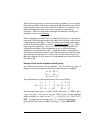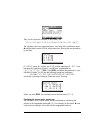
Page 11-40
To see the intermediate steps in calculating and inverse, just enter the matrix A
from above, and press Y, while keeping the step-by-step option active in the
calculator’s CAS. Use the following:
[[ 1,2,3],[3,-2,1],[4,2,-1]] `Y
After going through the different steps, the solution returned is:
What the calculator showed was not exactly a Gauss-Jordan elimination with
full pivoting, but a way to calculate the inverse of a matrix by performing a
Gauss-Jordan elimination, without pivoting. This procedure for calculating the
inverse is based on the augmented matrix (A
aug
)
n×n
= [A
n×n
|I
n×n
].
The calculator showed you the steps up to the point in which the left-hand half
of the augmented matrix has been converted to a diagonal matrix. From there,
the final step is to divide each row by the corresponding main diagonal pivot.
In other words, the calculator has transformed (A
aug
)
n×n
= [A
n×n
|I
n×n
], into [I
|A
-1
].
Inverse matrices and determinants
Notice that all the elements in the inverse matrix calculated above are divided
by the value 56 or one of its factors (28, 7, 8, 4 or 1). If you calculate the
determinant of the matrix A, you get det(A) = 56.
We could write, A
-1
= C/det(A), where C is the matrix
.
100
010
001
124
123
321
)(
⎥
⎥
⎥
⎦
⎤
⎢
⎢
⎢
⎣
⎡
−
−=
Iaug
A
.
8614
8137
880
⎥
⎥
⎥
⎦
⎤
⎢
⎢
⎢
⎣
⎡
−
−=
C


















